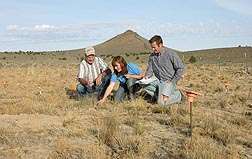In fall 2011, at ARS’s Northern Great Basin Experimental Range near Burns, Oregon, rangeland scientist Tony Svejcar (left), technician Lori Ziegenhagen, and plant physiologist Jeremy James examine the establishment of blue bunch wheatgrass. Credit: Lacy Carpenter.
Scientists at the U.S. Department of Agriculture (USDA) are making sure that money spent on sustaining and repairing arid rangeland ecosystems is spent on programs that work.
Agricultural Research Service (ARS) researchers in Burns, Ore., have identified factors that limit the success of rangeland restoration projects. ARS is USDA's chief intramural scientific research agency, and this work supports the USDA priority of responding to global climate change.
After wildfires, public land managers on western U.S. rangelands often quickly reseed burned areas to provide watershed protection and control soil erosion. Although seeds planted in the fall on postfire rangelands usually emerge the following spring, their low establishment rates are often attributed to insufficient precipitation or competition with invasive grasses.
Plant physiologist Jeremy James and research leader Tony Svejcar, who both work at the ARS Eastern Oregon Agricultural Research Center in Burns, compared the success of postfire reseeding management on four sites in Oregon where wildfires had burned a total of 300,000 acres.
The scientists obtained an assortment of seeds for several rangeland species. Then they seeded study plots either with a rangeland drill—a common practice in reseeding postfire sites—or placed seed in the soil by hand so that burial depth could be tightly controlled. In addition, irrigation and weeding was applied to some plots so the relative importance of seed placement, annual precipitation and competition from weeds could be assessed.
The best seed establishment occurred in hand-seeded plots with around 14 plants per square meter. The drilled plots had establishment rates of only around four plants per square meter, and weeding or watering management had no effect on seed establishment rates. The researchers also observed that although the wildfires at the four study sites burned away all the sagebrush, other quick-growing native perennial herbs soon recovered, which suggests that some postfire landscapes might not need reseeding at all.
The scientists believe these findings indicate that small improvements in seeding technology could yield large increases in rangeland restoration success. Results from this work were published in 2010 in Rangeland Ecology & Management.
More information: Read more about this project in the January 2012 issue of Agricultural Research magazine.
Provided by USDA Agricultural Research Service




















